Veliky Ustyug
Veliky Ustyug (Russian: Вели́кий У́стюг) is a town in Vologda Oblast, Russia, located in the northeast of the oblast at the confluence of the Sukhona and Yug Rivers. As of the 2010 Census, its population was 31,665.[4]
Veliky Ustyug Великий Устюг | |
|---|---|
Town[1] | |
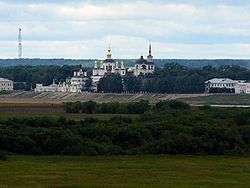 The Sukhona embankment, as seen from the Troitsko-Gledensky Monastery | |
 Flag _(2000).png) Coat of arms | |
Location of Veliky Ustyug 
| |
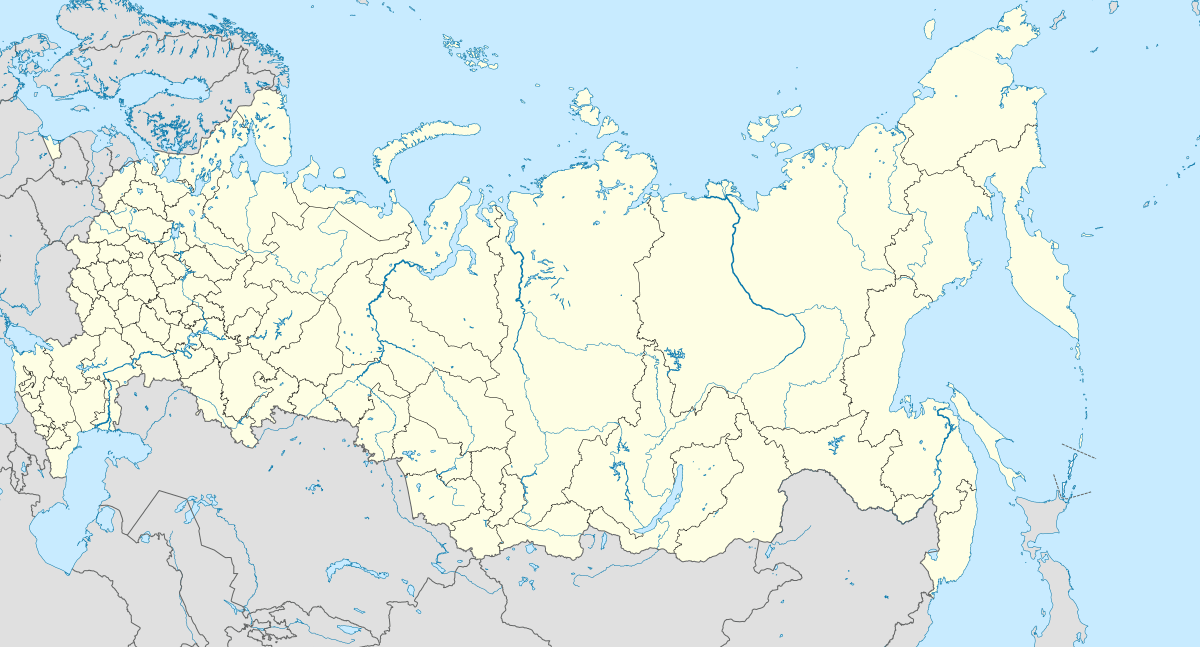 Veliky Ustyug Location of Veliky Ustyug 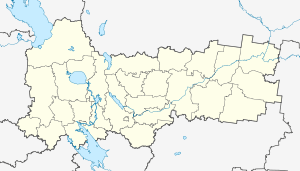 Veliky Ustyug Veliky Ustyug (Vologda Oblast) | |
| Coordinates: 60°46′N 46°18′E | |
| Country | Russia |
| Federal subject | Vologda Oblast[2] |
| First mentioned | 1207[3] |
| Elevation | 55 m (180 ft) |
| Population | |
| • Total | 31,665 |
| • Estimate (2018)[5] | 31,475 (-0.6%) |
| • Subordinated to | town of oblast significance of Veliky Ustyug[1] |
| • Capital of | Velikoustyugsky District[6], town of oblast significance of Veliky Ustyug[2] |
| • Municipal district | Velikoustyugsky Municipal District[7] |
| • Urban settlement | Veliky Ustyug Urban Settlement[7] |
| • Capital of | Velikoustyugsky Municipal District[7], Veliky Ustyug Urban Settlement[7] |
| Time zone | UTC+3 (MSK |
| Postal code(s)[9] | 160839, 162390, 162391, 162393, 162394, 162396, 162399 |
| Dialing code(s) | +7 81738 |
| OKTMO ID | 19614101001 |
| Website | www |
Veliky Ustyug has a great historical significance and was one of the major cities of the Russian North. It preserved some of the past urban structure and many of the architectural monuments. It has lost its former leading role and is nowadays mostly known for tourism.
Location and etymology
Veliky Ustyug is close to the confluence of the Sukhona (flowing from the west) and the Yug (from the south) rivers. Downstream from this confluence the rivers form a single waterway known as the Northern Dvina, sometimes referred to as the Little Northern Dvina. The historical center of the town is on the left (high) bank of the Sukhona and, in contrast to many historical Russian towns, there is an embankment along the Sukhona.
Dymkovskaya Sloboda and Troitse-Gledensky Monastery are on the right bank of the Sukhona. New parts of the town, mostly industrial areas, face the Northern Dvina. The only bridge in Veliky Ustyug is across the Sukhona upstream of the town center.
Previously, Gleden was a fortress, and the left bank of the Sukhona was a posad—a territory outside the fortress populated by craftsmen. In the 15th century, the fortress was destroyed in an attack by Vyatka army, and the new fortress was built in the former posad area. The fortress was demolished when it became apparent than no military threat to Veliky Ustyug exists.
The first recorded settlement in the area was the monastic settlement at Gleden (Гледен), founded near the confluence of the Yug and the Sukhona, where Troitsko-Gledensky Monastery is now. The name Ustyug means "the mouth of the Yug". By the late 15th century, the name changed to Veliky (Great) Ustyug.
History
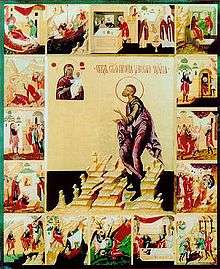
The town of Veliky Ustyug was first mentioned in a chronicle in 1207.[3] In 1212, Mikhaylo-Arkhangelsky Monastery was founded. It was a part of the Vladimir-Suzdal Principality (in contrast to the neighboring lands, most notably Totma, colonized by Novgorod). Thus Veliky Ustyug created the only obstacle to Novgorod's trade with the north, as the Sukhona and the Northern Dvina were the main waterways connecting Novgorod with the White Sea. Clashes between Novgorod and Ustyug became regular, especially throughout the whole 14th century.[10] In 1328, Ustyug was annexed by the Grand Duchy of Moscow.
The town was not immediately affected by the Mongol invasion of Rus' in the 13th century; however, its rapid growth in the second half of the century was due to influx of refugees from Central Russia.[10]
In the 15th century, Veliky Ustyug became notable for the war between Vasily II of Moscow and his cousin Dmitry Shemyaka, which left northern Russia deserted. Shemyaka took Veliky Ustyug in 1450, drowned in the Sukhona those citizens who refused to accept him as a prince, and made the town his residence for two years, until he was driven off by the forces of Vasily.[10] In the 15th century, the town had a great military importance and became the base for the operations against the Finno-Ugric peoples.
In 1613, during the Time of Troubles, Veliky Ustyug was besieged by Polish troops but never taken.[10] At the junction of important trade routes, the town turned into a significant commercial and industrial center in the 16th and 17th centuries. Veliky Ustyug area was the birthplace of the explorers Semyon Dezhnyov, Yerofey Khabarov, Vladimir Atlasov, and of St. Stephen of Perm. Veliky Ustyug lost its key role as a river port with the diminishing importance of the Sukhona River route for trade between China and western Europe, which started with the foundation of Saint-Petersburg in 1703, whereby the trade was diverted to the Baltic Sea.
The 16th and 17th centuries were the time of the highest rise of the culture in Veliky Ustyug, in which it acquired a national-wide significance. The town is known for its remarkable handicrafts, such as silver filigree, birch bark fretwork, decorative copper binding, and niello. The town developed a distinct manner of icon painting — Ustyug icon painting. In the 17th century, Veliky Ustyug was a major producer of tiles, which are visible on many Ustyug churches and were sold to neighboring towns of the Russian North. On January 25, 1613, the town was unsuccessfully besieged by Polish-Lithuanian vagabonds (see Lisowczycy) led by Jakub Jacki.
In the course of the administrative reform carried out in 1708 by Peter the Great, Veliky Ustyug was explicitly mentioned as one of the 20 towns included into the Archangelgorod Governorate. From 1719, it was the center of Ustyug Province, one of the four provinces of the Governorate. In 1780, the governorate was abolished and transformed into Vologda Viceroyalty. The latter was abolished in 1796, and Veliky Ustyug became the center of Velikoustyugsky Uyezd of Vologda Governorate. In 1918, the town became the administrative center of the newly established Northern Dvina Governorate. In 1924, the uyezds were abolished in favor of the new divisions, the districts (raions).
In 1929, Northern Dvina Governorate was merged into Northern Krai. The krai consisted of five okrugs, one of which, Northern Dvina Okrug, had its administrative center in Veliky Ustyug. In July 1930, the okrugs were abolished, and the districts were directly subordinated to Northern Krai. In 1936, Northern Krai was transformed into Northern Oblast, and in 1937, Northern Oblast was split into Arkhangelsk Oblast and Vologda Oblast. Veliky Ustyug remained in Vologda Oblast ever since.
Veliky Ustyug, in contrast to the majority of historical Russian towns, managed to preserve almost all of its architectural and cultural monuments. This was in a great part due to the efforts of the local intellectuals grouped around the Regional Museum, and most notably of Nikolay Bekryashev, the museum director from 1924 to 1938. This group managed to convince the authorities that the churches and old buildings have a historical significance and must be handed in the museum rather than demolished.
Administrative and municipal status
Within the framework of administrative divisions, Veliky Ustyug serves as the administrative center of Velikoustyugsky District,[6] even though it is not a part of it.[1] As an administrative division, it is, together with the town of Krasavino and the work settlement of Kuzino, incorporated separately as the town of oblast significance of Veliky Ustyug—one of the four administrative units in the oblast with the status equal to that of the districts.[2] Within the framework of municipal divisions, the town of Veliky Ustyug, together with the village of Slobodka in Yudinsky Selsoviet of Velikoustyugsky District is incorporated as Veliky Ustyug Urban Settlement within Velikoustyugsky Municipal District.[7] The town of Krasavino, together with six rural localities in Krasavinsky Selsoviet of Velikoustyugsky District, is incorporated as Krasavino Urban Settlement, and the work settlement of Kuzino is incorporated as Kuzino Urban Settlement; both also within Velikoustyugsky Municipal District.[7]
Economy
Industry
There are timber industry enterprises in Veliky Ustyug, as well as a shipyard, food industry, and enterprises serving the tourist industry — in particular, the jewelry production plant.[11]
Tourism is an important branch of economy in Veliky Ustyug. It started in the 1960s and got a further boost in 1990s when Veliky Ustyug started to be marketed as the residence of Ded Moroz, also known as "Grandfather Frost".
Transportation
Roads connect Veliky Ustyug with other towns. The road to the north runs to Krasavino and further to Kotlas. The one to the south runs to Nikolsk and further to Manturovo, where it connects to the road to Kostroma. The road to the southwest connects Veliky Ustyug with Vologda via Totma. It was built in the beginning of the 21st century; before this road was opened, the only way to get from Veliky Ustyug to Vologda was via Nikolsk and Totma. All these roads are paved.
An unpaved road, originating from Kuzino (which is connected with Veliky Ustyug by a ferry crossing) runs to Luza and continues to Lalsk and further to the Komi Republic.
The railroad connects Veliky Ustyug with Yadrikha railway station on the railroad connecting Konosha and Kotlas. The passenger service to Veliky Ustyug was discontinued in 2005.
The Sukhona, the Yug, and the Northern Dvina are all navigable in Veliky Ustyug, but there is no passenger navigation except for ferry crossings.
Veliky Ustyug is served by the Veliky Ustyug Airport with occasional passenger service to Vologda.
Demographics
| 2010 Census | 31,665[4] |
|---|---|
| 2002 Census | 33,419[12] |
| 1989 Census | 36,202[13] |
| 1979 Census | 37,916[14] |
The population of Veliky Ustyug was steadily growing until the second half of 20th century, but in the recent years it has been on decline, as is the general trend in Russia.
Main sights
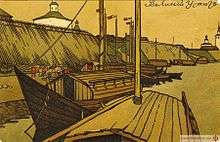

Veliky Ustyug preserves much of its architectural heritage and has one of the best preserved architectural ensembles in Russia. The town contains 152 objects classified as cultural and historical heritage by the Russian Federal law and 25 objects classified as cultural and historical heritage of local importance.[15] It is classified as a historical town by the Ministry of Culture of Russian Federation, which implies certain restrictions on construction in the historical center.[16]
Most of the architectural monuments are on the left bank of the Sukhona, and many of these are the living houses. The exceptions are Troitsko-Gledensky Monastery and the Dymkovo Sloboda, on the right bank of the Sukhona. Troitsko-Gledensky Monastery is in the village of Morozovitsa, in Velikoustyugsky District.
The principal architectural ensembles of Veliky Ustyg are
- The old Sobornoye Dvorishche (Cathedral Square), with the ensemble of Assumption Cathedral (1619–1659), the St. Prokopius Cathedral (1668, Prokopius is the local saint who lived in Ustyug), the Cathedral of St. John the Righteous (1656—1663), and the Epiphany Church (1689)
- Mikhaylo-Arkhangelsky Monastery with the Cathedral of Archangel Michael (1653—1656), the Presentation Church (1653), the Gate Church of St. Vladimir (1682), and the Church of Mid-Pentecost (1710), the wall with towers and the cells
- Former transfiguration monastery: The Transfiguration Church, the Presentation Church (1725–1739), and the St. George Church (1696–1704)
- The St. Nicholas Church with the bell-tower (17th century)
- The Ascension Church (1648)
- The Church of Women Bearing Myrrh (1714–1722)
- The Church of St. Simeon the Stylite (18th century)
The monuments of civil architecture are mostly concentrated along the Sukkhona, along Sovetsky Avenue and Krasnaya Street.
Some of these buildings belong to the Velikoustyugsky Museum of History, Art, and Architecture.[17] The museum was open in 1909 in the premises of Mikhaylo-Arkhangelsky Monastery. In 1918 it was transformed into the Museum of the Northern Dvina Culture. Between 1924 and 1938 the museum director was Nikolay Bekryashev, an artist, who devoted his energy to extending the museum to the old buildings, mostly churches, of the town, which thus were saved from destruction. In particular, a big collection of icons and objects of applied arts survived. Despite the efforts of Bekryashev and other museum employees, some of the buildings were destroyed by the authorities.[18] The museum currently serves as an umbrella institution that organizes permanent and temporary exhibits in the former church buildings.
Culture
In 1998, Moscow Mayor Yury Luzhkov proposed to officially locate the residence of Ded Moroz, a fictional character somewhat similar to Santa Claus, in Veliky Ustyug. The residence, which is a resort promoted as the Votchina ("estate") of Ded Moroz, is a major tourist attraction.[19] It is 16 km from the town, on the premises of Velikoustyugsky District. There is a dedicated post office there that answers children's mail to Ded Moroz.
See also
References
Notes
- Resolution #178
- Law #371-OZ
- Энциклопедия Города России. Moscow: Большая Российская Энциклопедия. 2003. p. 64. ISBN 5-7107-7399-9.
- Russian Federal State Statistics Service (2011). "Всероссийская перепись населения 2010 года. Том 1" [2010 All-Russian Population Census, vol. 1]. Всероссийская перепись населения 2010 года [2010 All-Russia Population Census] (in Russian). Federal State Statistics Service.
- "26. Численность постоянного населения Российской Федерации по муниципальным образованиям на 1 января 2018 года". Federal State Statistics Service. Retrieved January 23, 2019.
- Государственный комитет Российской Федерации по статистике. Комитет Российской Федерации по стандартизации, метрологии и сертификации. №ОК 019-95 1 января 1997 г. «Общероссийский классификатор объектов административно-территориального деления. Код 19 214», в ред. изменения №278/2015 от 1 января 2016 г.. (State Statistics Committee of the Russian Federation. Committee of the Russian Federation on Standardization, Metrology, and Certification. #OK 019-95 January 1, 1997 Russian Classification of Objects of Administrative Division (OKATO). Code 19 214, as amended by the Amendment #278/2015 of January 1, 2016. ).
- Law #1109-OZ
- "Об исчислении времени". Официальный интернет-портал правовой информации (in Russian). June 3, 2011. Retrieved January 19, 2019.
- Почта России. Информационно-вычислительный центр ОАСУ РПО. (Russian Post). Поиск объектов почтовой связи (Postal Objects Search) (in Russian)
- История Великого Устюга (in Russian). vologdaobl.ru. Retrieved September 6, 2011.
- О городе (in Russian). Администрация МО «Город Великий Устюг». Retrieved September 7, 2011.
- Russian Federal State Statistics Service (May 21, 2004). "Численность населения России, субъектов Российской Федерации в составе федеральных округов, районов, городских поселений, сельских населённых пунктов – районных центров и сельских населённых пунктов с населением 3 тысячи и более человек" [Population of Russia, Its Federal Districts, Federal Subjects, Districts, Urban Localities, Rural Localities—Administrative Centers, and Rural Localities with Population of Over 3,000] (XLS). Всероссийская перепись населения 2002 года [All-Russia Population Census of 2002] (in Russian).
- "Всесоюзная перепись населения 1989 г. Численность наличного населения союзных и автономных республик, автономных областей и округов, краёв, областей, районов, городских поселений и сёл-райцентров" [All Union Population Census of 1989: Present Population of Union and Autonomous Republics, Autonomous Oblasts and Okrugs, Krais, Oblasts, Districts, Urban Settlements, and Villages Serving as District Administrative Centers]. Всесоюзная перепись населения 1989 года [All-Union Population Census of 1989] (in Russian). Институт демографии Национального исследовательского университета: Высшая школа экономики [Institute of Demography at the National Research University: Higher School of Economics]. 1989 – via Demoscope Weekly.
- "Всесоюзная перепись населения 1979 г. Национальный состав населения по регионам России" [All Union Population Census of 1979. Ethnic composition of the population by regions of Russia] (XLS). Всесоюзная перепись населения 1979 года [All-Union Population Census of 1979] (in Russian). 1979 – via Demoscope Weekly (website of the Institute of Demographics of the State University—Higher School of Economics.
- Памятники истории и культуры народов Российской Федерации (in Russian). Russian Ministry of Culture. Retrieved June 2, 2016.
- "Приказ Министерства культуры Российской Федерации, Министерства регионального развития Российской Федерации от 29 июля 2010 г. N 418/339 г. Москва "Об утверждении перечня исторических поселений"" (in Russian). Российская газета. September 29, 2010. Retrieved October 24, 2011.
- "The museum of Velikij Ustyug". Veliky Ustyug Museum. Retrieved September 7, 2011.
- Музей Северодвинской культуры: страницы истории. (in Russian). Veliky Ustyug Museum. Retrieved September 7, 2011.
- Великий Устюг - родина Деда Мороза (in Russian). Департамент международных, межрегиональных связей и туризма Вологодской области. Retrieved September 7, 2011.
Sources
- Законодательное Собрание Вологодской области. Закон №371-ОЗ от 4 июня 1999 г. «О вопросах административно-территориального устройства Вологодской области», в ред. Закона №2916-ОЗ от 7 декабря 2012 г. «О внесении изменений в Закон области "О вопросах административно-территориального устройства Вологодской области"». Вступил в силу со дня официального опубликования. Опубликован: "Красный Север", №124–125, 29 июля 1999 г. (Legislative Assembly of Vologda Oblast. Law #371-OZ of June 4, 1999 On the Matters of the Administrative-Territorial Structure of Vologda Oblast, as amended by the Law #2916-OZ of December 7, 2012 On Amending the Oblast Law "On the Matters of the Administrative-Territorial Structure of Vologda Oblast". Effective as of the day of the official publication.).
- Правительство Вологодской области. Постановление №178 от 1 марта 2010 г. «Об утверждении реестра административно-территориальных единиц Вологодской области», в ред. Постановления №686 от 25 июня 2012 г. «О внесении изменений в некоторые Постановления Правительства области». Вступил в силу 20 марта 2010 г. Опубликован: "Красный Север", №29, 20 марта 2010 г. (Government of Vologda Oblast. Resolution #178 of March 1, 2010 On Adopting the Registry of the Administrative-Territorial Units of Vologda Oblast, as amended by the Resolution #686 of June 25, 2012 On Amending Various Resolutions of the Oblast Government. Effective as of March 20, 2010.).
- Законодательное Собрание Вологодской области. Закон №1109-ОЗ от 6 декабря 2004 г. «Об установлении границ Великоустюгского муниципального района, границах и статусе муниципальных образований, входящих в его состав», в ред. Закона №3669-ОЗ от 1 июня 2015 г. «О преобразовании некоторых муниципальных образований Великоустюгского муниципального района Вологодской области и о внесении изменений в Закон области "Об установлении границ Великоустюгского муниципального района, границах и статусе муниципальных образований, входящих в его состав"». Вступил в силу через 10 дней со дня официального опубликования. Опубликован: "Красный Север", №242, 11 декабря 2004 г. (Legislative Assembly of Vologda Oblast. Law #1109-OZ of December 6, 2004 On Establishing the Borders of Velikoustyugsky Municipal District, on the Borders and Status of the Municipal Formations It Comprises, as amended by the Law #3669-OZ of June 1, 2015 On the Transformation of Several Municipal Formations in Velikoustyugsky Municipal District of Vologda Oblast and on Amending the Law of Vologda Oblast "On Establishing the Borders of Velikoustyugsky Municipal District, on the Borders and Status of the Municipal Formations It Comprises". Effective as of after 10 days from the day of the official publication.).
Further reading
- (in Russian) Ustyug Great. Materials for the History of the 17th and 18th Centuries (1883) (Устюг Великий. Материалы для истории города XVII и XVIII столетий) at Runivers.ru in DjVu and PDF formats
- Brumfield, William C. Velikii Ustiug (Moscow: Tri Kvadrata, 2007) OCLC 174531901 (in English and Russian)
- Brumfield, W (Undated) Veliky Ustyug: A view through the lens of an American scholar-photographer. Full text available at www.pomorsu.ru/Brumfield/velikii_ustiug.htm
- Gardner, N (2005) Article in hidden Europe magazine, 5 (Nov 2005), pp. 22–26. Full text available (html and pdf versions) at hidden europe website
External links
| Wikivoyage has a travel guide for Veliky Ustyug. |
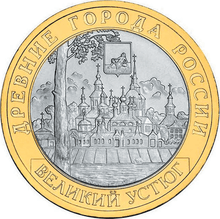
- Official website of Veliky Ustyug (in Russian)
- Museum complex of Veliky Ustyug
- Veliky Ustiug: Northern Jewel with photos, William Brumfield, April 20, 2010, Russia Beyond the Headlines